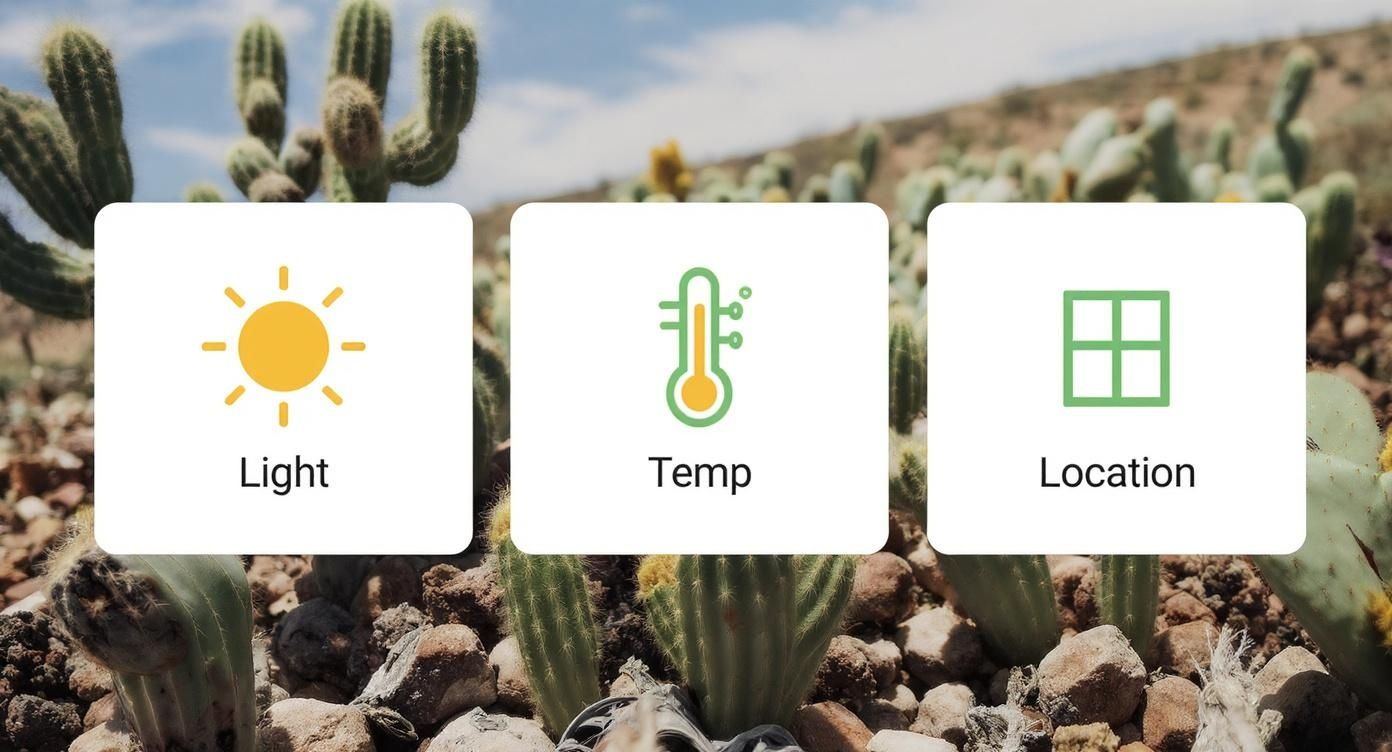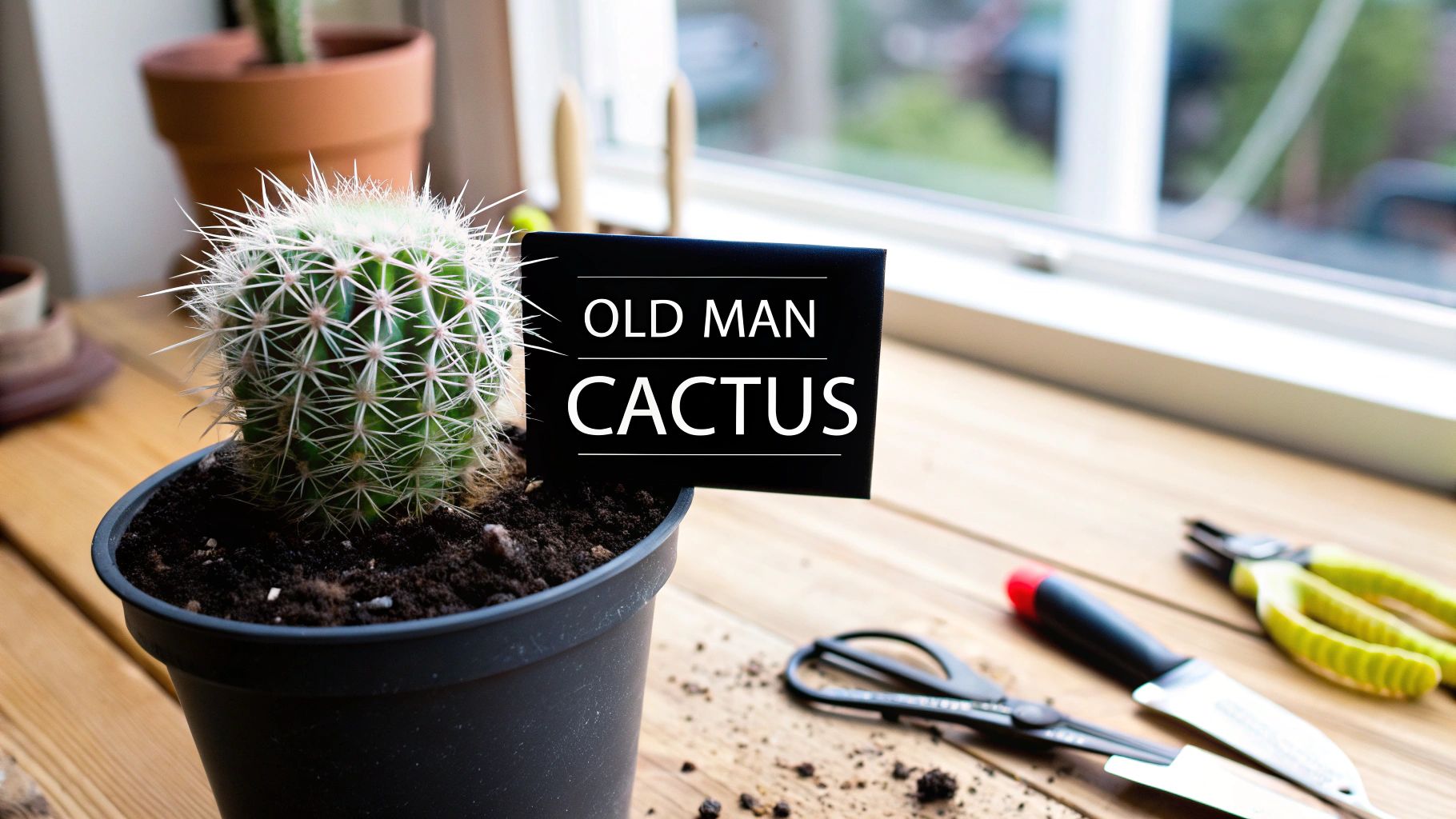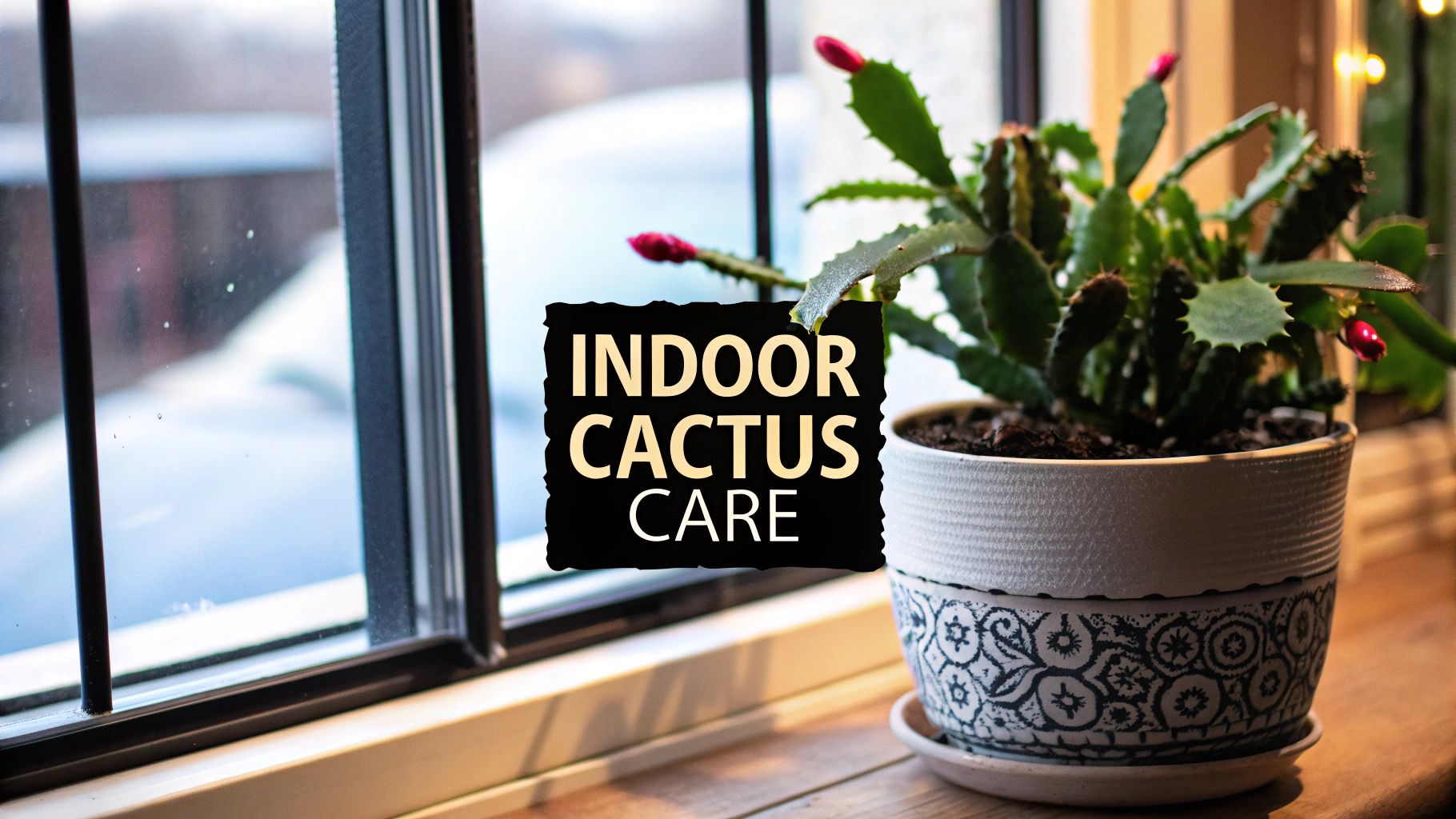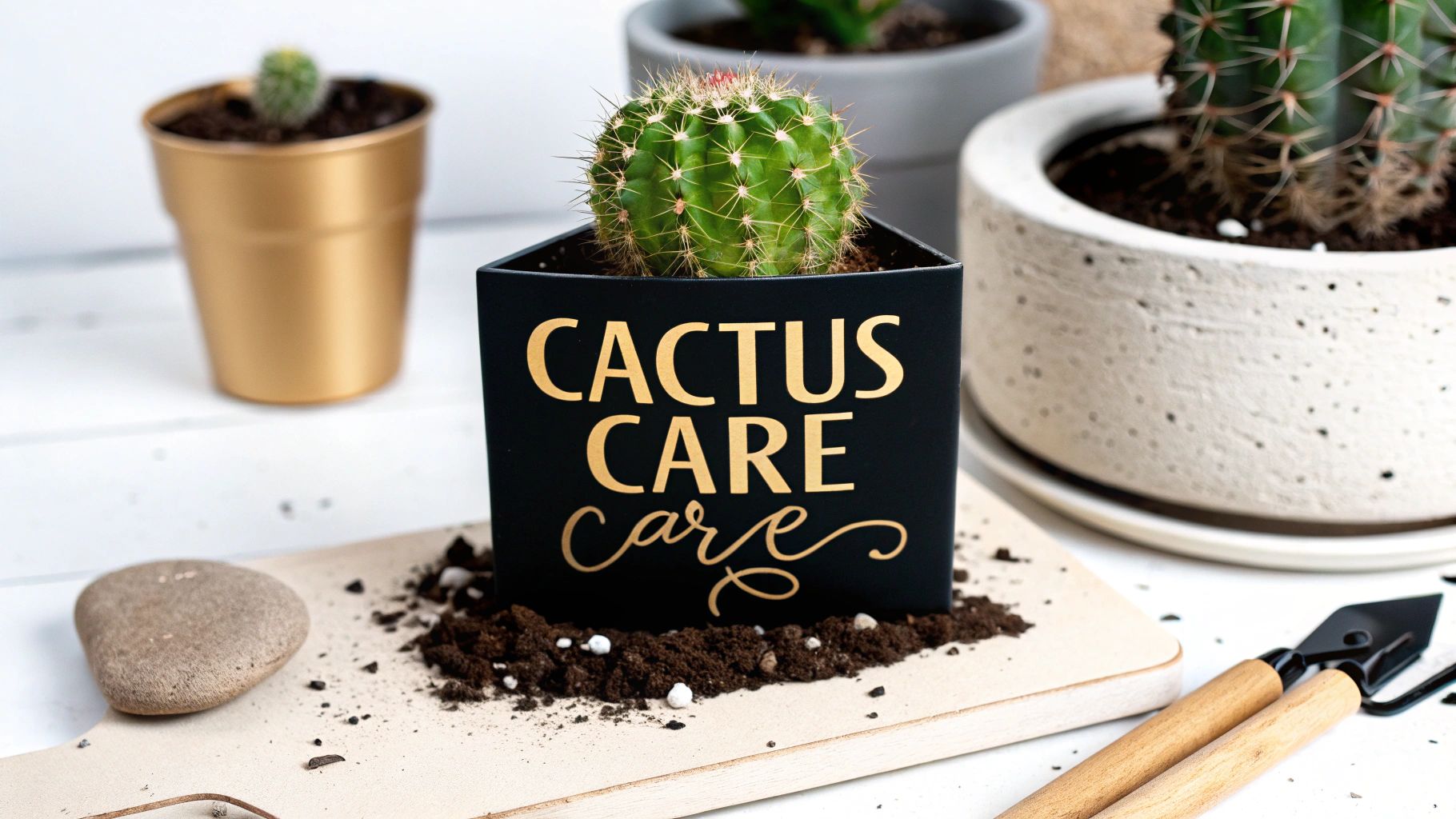When you get the hang of it, caring for an Old Man Cactus is pretty straightforward. The magic formula is bright, direct sunlight, a fast-draining soil mix, and a "soak and dry" watering method. Those iconic white, hair-like spines aren't just for looks, either—they're a clever adaptation that protects the cactus from intense sun and wild temperature swings.
Getting to Know the Old Man Cactus

The Old Man Cactus, or Cephalocereus senilis if you want to get scientific, is less of a houseplant and more of a living sculpture. This fascinating cactus comes from the sun-baked, arid landscapes of central Mexico, where it developed some incredible survival skills. Those same traits make it a tough and forgiving plant for your home.
Its most famous feature is, of course, the thick coat of long, woolly filaments that cover its stem. This "hair" is more than just a cool look; it's a multi-tool for survival.
- Natural Sunscreen: The white filaments reflect the harsh sun, shielding the cactus's green skin from getting scorched.
- Climate Control: This fuzzy coat traps air, creating an insulating layer against the desert's extreme heat during the day and chilly temperatures at night.
- Moisture Magnet: In the wild, the hair can even collect morning dew, giving the cactus a little extra moisture to get by.
A True Fan Favorite
With its unique look and relatively simple care needs, Cephalocereus senilis has become a beloved plant across the globe. It's especially popular in North America and Europe, where succulent and cactus collections are booming. In fact, the demand for ornamental cacti has jumped by about 25% in the last decade alone.
The global market hit over $1.2 billion in 2023, and the Old Man Cactus accounted for roughly 8% of cactus sales at major nurseries. It's a testament to its enduring charm.
This guide will walk you through everything you need to know. We’ll cover the three pillars of its health—light, water, and soil—in the sections ahead, so you can help your fuzzy friend thrive.
What to Expect With Your Cactus
Before we get into the details, it's good to set some realistic expectations. The Old Man Cactus teaches patience. It’s a very slow grower, often putting on less than an inch of height per year when kept indoors. This slow-and-steady pace is part of its appeal, making it a low-fuss companion that won't outgrow its pot anytime soon.
For new owners, it's crucial to know that getting an indoor Old Man Cactus to flower is a rare achievement. It can take 10 years or more for the plant to be mature enough to produce its stunning nocturnal blooms. The real reward is enjoying its unique form as it grows.
While the classic Cephalocereus senilis is the one you'll see most often, there are other interesting varieties out there. You might come across the Peruvian Old Man Cactus, which has its own distinct look. Knowing the subtle differences can help you fine-tune your care routine and truly appreciate the quiet, steady journey of your plant.
Finding the Perfect Spot: Light and Temperature Needs
The first step in proper Old Man Cactus care is finding its happy place. This isn't just about finding an empty windowsill; it's about recreating the high-altitude desert sun it's used to. Honestly, getting the light right is the most critical part of keeping this cactus healthy and looking its best.
Unlike a lot of houseplants that get crispy with too much sun, the Old Man Cactus is a true sun-worshipper. It needs at least six hours of bright, direct sunlight every day. That iconic white "hair" isn't just for show—it's natural sunscreen, protecting the cactus from intense rays. Without enough light, that beautiful fuzz will thin out, and the plant's growth will suffer.
Decoding Your Home's Sunlight
You often hear the term "bright, indirect light" for houseplants, but for Cephalocereus senilis, you'll want to take it up a notch. The absolute best spot is a south-facing window, where it can just soak up the sun all day long.
- South-Facing Window: This is the gold standard. It provides the intense, direct light this cactus craves to thrive.
- West-Facing Window: A fantastic alternative. It gets blasted with strong afternoon and evening sun, which is more than enough to keep it happy.
- East-Facing Window: This spot is workable, but you'll need to keep an eye on your plant. Morning sun is much gentler, and you might notice your cactus starting to lean or stretch, reaching for more light. If you use an east-facing window, be sure to rotate it regularly.
Your cactus will definitely let you know if it's not getting enough light. The biggest red flag is etiolation—it will start to look stretched out, thin, and pale at the top. The hair might also look sparse as the plant pours all its energy into finding a better light source. While our focus is on this sun-lover, understanding diverse plant light needs can offer a great perspective on just how different requirements can be from one plant to another.
When Sunlight Gets Too Intense
Even a sun-lover can have its limits. If you live somewhere with incredibly hot summers, like Arizona or parts of Southern California, the sun coming through a window can act like a magnifying glass. This can sometimes be too much, even for an Old Man Cactus, and you might notice its white hairs turning a little yellow or brown.
If you see this happening, don't panic and move it to a dark room. The fix is simple: just pull it back a foot or two from the glass or hang a sheer curtain to cut the harshest midday glare. You're aiming to filter the light, not block it. For more ideas on placement, our guide on where to put a cactus in your house has some great room-by-room tips.
Ideal Temperature and Seasonal Shifts
The Old Man Cactus is tough, but it prefers a stable environment. During its growing season in spring and summer, it's perfectly happy in typical indoor temperatures, anywhere from 65°F to 85°F (18°C to 29°C).
What it doesn't like are sudden temperature swings.
Keep your cactus away from drafty windows, AC vents, and heaters. Those constant blasts of hot or cold air are stressful and will slow down its already patient growth.
Come fall and winter, the cactus needs to go dormant. This is a crucial rest period. To help it along, you'll want to move it to a cooler spot, ideally somewhere between 50°F and 60°F (10°C to 15°C). An unheated garage with a window or a protected porch in a mild climate works perfectly. This cool, dry rest is the secret to encouraging flowers on mature plants in the spring. During dormancy, watering is also cut way back, which we'll dive into next. By managing its environment through the seasons, you're giving it the cues it needs to follow its natural life cycle.
Getting Water and Feeding Right
If there’s one thing that trips people up with Old Man Cactus care, it’s watering. I've seen it time and again—it’s the number one reason these otherwise tough plants fail. But it doesn't have to be a guessing game. The secret is to ditch rigid schedules and start paying attention to what the plant and its soil are telling you.
The gold standard here is the "soak and dry" method. Think about where these guys come from—the Mexican desert. They're used to long dry spells followed by a massive downpour. We want to mimic that. When it's time to water, give it a thorough drenching until you see water flowing freely from the drainage holes. Then, and this is the important part, let the soil dry out completely before you even think about watering again.
This visual guide gives you a great overview of the environmental factors that dictate just how thirsty your cactus will get.

As you can see, light, temperature, and where you place your plant are all connected. A cactus in a hot, sunny window will need water far more often than one in a cooler, shadier spot.
How to Tell When It’s Truly Dry
So, how do you know for sure? Your finger is honestly the best tool you have. Push it about two inches down into the soil. If you feel even a hint of coolness or moisture, step away from the watering can. If it’s dusty and bone-dry, it’s go time.
Don't forget to consider the pot. A classic terracotta pot is porous and breathes, so the soil will dry out much faster. A glazed ceramic or plastic pot, on the other hand, holds moisture for a lot longer. This is exactly why a generic "water every two weeks" rule is a recipe for disaster.
I can't stress this enough: overwatering is the fastest way to kill an Old Man Cactus. Their roots simply can't handle sitting in damp soil, and it will quickly lead to root rot—a fungal disease that’s almost impossible to come back from. When in doubt, always wait another day or two.
Reading the Signs of Trouble
Your cactus will give you little hints about how it’s feeling. Learning to spot them is a game-changer.
- Signs of Underwatering: Is your cactus looking a bit shriveled or wrinkly? Has its growth stalled? It's probably thirsty. The good news is this is a much easier fix than the alternative.
- Signs of Overwatering: This is the one to watch out for. The base of the cactus might feel soft, turn yellow, or even get mushy. That’s a classic sign root rot has already taken hold beneath the soil. You might also notice a damp, musty smell.
If you want to dive deeper into this topic, this excellent guide to watering cactus plants has some fantastic tips for all sorts of scenarios.
A Simple Feeding Strategy
Old Man Cacti are very low-maintenance when it comes to food. They're built for poor soils and grow at a snail's pace, so you don't need to go crazy with fertilizer. That said, a little boost during the growing season can really support its health and keep that iconic white hair looking its best.
The active growing season, from spring through summer, is the only time you should be feeding it. A good rhythm is to fertilize once every 4-6 weeks during this period.
Always reach for a fertilizer made specifically for cacti and succulents. These formulas are low in nitrogen and have more phosphorus and potassium, which helps build strong roots instead of weak, leggy growth. It's also critical to dilute it to half-strength to avoid burning the plant’s sensitive roots.
Never fertilize a cactus when its soil is bone-dry; water it thoroughly a day or so before you plan to feed it. Once fall arrives, stop all fertilizing. The cactus is heading into its winter dormancy and doesn't need the extra nutrients—feeding it now can just mess with its natural cycle.
To keep things simple, here’s a quick-reference table for adjusting your care routine as the seasons change.
Seasonal Care at a Glance
| Season | Watering Frequency | Fertilizing Schedule | Light and Temperature Notes |
|---|---|---|---|
| Spring | Increase as days get longer and warmer. Water when soil is fully dry. | Start feeding once every 4-6 weeks with half-strength cactus fertilizer. | Move to a brighter spot if needed. Protect from late frosts. |
| Summer | Water most frequently, but always check soil first. May be every 7-14 days. | Continue feeding every 4-6 weeks. This is peak growing season. | Provide maximum light. Can be moved outdoors, but acclimate it first. |
| Fall | Gradually reduce watering as days shorten and cool down. | Stop all fertilizing by the end of the season to prepare for dormancy. | Bring indoors before the first frost. Light levels will naturally decrease. |
| Winter | Water very sparingly, maybe once a month or even less. | No fertilizer. The plant is resting. | Keep in a bright but cool spot. Avoid placing it near drafts or heaters. |
This table serves as a handy guide, but remember to always let your specific environment and the state of your cactus's soil be your ultimate guide.
Choosing the Right Soil and When to Repot

The secret to a happy Old Man Cactus lies right under its feet—in the soil. This is where so many people go wrong. These guys are desert plants through and through, meaning they absolutely despise "wet feet." Standard potting soil is their worst enemy; it acts like a sponge, holding onto water and practically begging for root rot.
To keep your Cephalocereus senilis thriving, you need a soil mix that drains like a sieve. Think about its native home in Mexico—the soil there is gritty, rocky, and doesn't hold much water. Your goal is to replicate that. A fast-draining mix allows water to flush through, giving the roots a quick drink without leaving them to sit in a swamp.
Crafting the Perfect Cactus Soil Mix
You can grab a bag of "Cactus & Succulent Mix" from the store, but honestly, most of them are still too rich and heavy for this true desert specialist. They're a decent start, but I always end up amending them to add more grit.
Even better, just make your own. It's incredibly easy and gives your cactus exactly what it needs. Here’s my go-to recipe for a perfect, gritty mix:
- One part standard potting soil: This just provides a little organic matter and a base.
- One part coarse sand or horticultural grit: This is key for creating air pockets and preventing compaction. Just be sure to avoid fine play sand, which will turn your soil into concrete.
- One part perlite or pumice: These lightweight volcanic rocks are champions of aeration, making sure water drains away in a hurry.
Just mix these three ingredients together in a bucket, and you've got a custom blend your Old Man Cactus will thank you for.
Knowing When It's Time to Repot
Since these cacti grow at a glacial pace, you won't be repotting them all the time. Plan on giving your cactus a new home every two to four years, maybe even longer. Over-potting is stressful for the plant, so it's better to let it get a little snug.
Instead of marking your calendar, just watch the plant for clues. It's probably time for an upgrade if you see:
- Roots peeking out of the drainage holes.
- The cactus looks wobbly or top-heavy for its pot.
- Water rushes straight through the soil without seeming to absorb, a sign the soil is depleted and compacted.
- There's almost no space between the cactus and the rim of the pot.
The best time of year for this task is late spring or early summer. This lines up with the start of their growing season, giving the cactus plenty of energy to settle into its new home before it slows down for winter.
How to Repot Your Cactus
Okay, handling a spiny plant takes a little finesse, but it's not hard. First, pick a new pot that’s only 1-2 inches wider than the current one. A pot that's too big will hold too much soil, and therefore too much moisture, putting you right back in rot territory. Drainage holes are non-negotiable.
To get a grip on the cactus without getting poked, wrap it in a thick, folded towel or several layers of newspaper. Heavy-duty garden gloves are also a great idea. Gently tip the pot over and slide the cactus out. Take a quick look at the roots—trim off any that are black, mushy, or completely shriveled up.
Add a layer of your fresh, gritty soil mix to the new pot. Set the cactus in the middle, making sure it sits at the same depth it was in its old pot. Fill in around the sides with more soil, gently patting it down to eliminate major air pockets.
Now for the most important part, and it's a tip many people miss: do not water it! Let the cactus sit dry in its new pot for at least a week. This gives any roots that were bruised or broken during the move a chance to heal and callus over. Watering too soon is the fastest way to invite rot into those tiny wounds.
Tackling Common Pests and Problems
Even a tough old cactus isn't invincible. That signature woolly hair, while great for sun protection, unfortunately makes a five-star hotel for tiny pests. But don't worry—spotting and dealing with these issues is pretty simple once you know what to look for. The trick is to act fast.
Most of the time, any trouble you run into will be one of two things: bugs or a simple care mistake. Pests can be handled with some targeted treatments, and things like a yellowing stem are usually just your cactus telling you it wants a change of scenery or a different watering schedule.
On the Lookout for Cactus Critters
That dense, white fluff is the perfect hiding spot for pests, so you'll want to make regular inspections part of your routine. I find it easiest to just gently part the hairs and take a good look at the green skin underneath, especially around the top where new growth is tender and tasty.
Here’s who you’re most likely to find crashing the party:
- Mealybugs: These are public enemy number one for an Old Man Cactus. They show up as tiny, white, cotton-like fluff, usually tucked away in crevices. They suck the life out of your plant and leave behind a sticky mess called honeydew.
- Spider Mites: These guys are almost microscopic, so you probably won't see the mites themselves. Your first clue will be very fine, delicate webbing stretched between the spines. They also feed on sap, causing yellow or faded-looking spots on the cactus skin.
- Scale Insects: Look for small, hard, brown bumps latched onto the stem. They look more like a weird growth than a bug. Just like the others, they feed on plant juices and can really slow down your cactus if they take hold.
Getting rid of these pests is all about being gentle but persistent. I always start with the simplest fix first.
For a few mealybugs or scale, your best weapon is a cotton swab and some 70% isopropyl alcohol. Just dip the swab and dab it directly on the pest. The alcohol dissolves their protective coating and sorts them out instantly.
If you’re dealing with a bigger invasion, it's time to bring out an insecticidal soap or a neem oil solution. Mix it up according to the package directions and give the whole cactus a good spray, really getting into all the nooks and crannies. You'll need to do this every 5-7 days for a couple of weeks to make sure you get any new bugs that hatch.
Figuring Out What Your Cactus Is Telling You
Sometimes, the problem isn't a bug at all—it's environmental. Your cactus will give you clear visual cues about what’s wrong. Learning to speak its language is the key to great care.
A Yellow or Mushy Base
This is the one that sets off alarm bells. A soft, yellow bottom almost always means one thing: overwatering. The soil has been wet for too long, and the roots are starting to rot. If you catch it early, stop watering right away and let the soil dry out completely. More airflow can help, too.
A Shriveling or Wrinkled Stem
Seeing your cactus look a bit deflated or wrinkly? It's probably just thirsty—an easy fix! The plant is just running low on its internal water stores. Give it a good, deep drink using the "soak and dry" method, and it should plump right back up in a day or two.
A Brown, Woody Base (Corking)
Now, if you see the base of your cactus turning brown and hard like bark, don't panic. If it’s firm to the touch (not mushy), this is probably just corking. It's a totally natural part of aging where the cactus strengthens its base to support its weight as it gets taller. It's a sign of a mature, healthy plant
Understanding Slow Growth and How to Propagate
Owning an Old Man Cactus is a masterclass in patience. This isn't a plant that's going to shoot up overnight; its charm lies in its slow, deliberate growth, making it a true long-term companion for your home. Think of its glacial pace as a feature, not a bug.
The growth rate of Cephalocereus senilis is famously slow. Even under perfect indoor conditions, you're looking at maybe half an inch of new height per year. This incredibly gradual journey means that seeing one flower is a rare and special event. Most plants won't even think about blooming until they're 10 to 20 years old, finally mature enough to produce their gorgeous nocturnal flowers. For a deeper dive into its lifecycle, the experts at Britannica offer some great information.
While you won't be seeing rapid changes, you can still multiply your collection by propagating new plants. It's a surprisingly simple and rewarding process that gives you a new appreciation for the plant's resilience.
Propagating from Cuttings
Propagating an Old Man Cactus is pretty straightforward, but success really boils down to getting a few key details right to prevent rot. The best time to take cuttings is during the active growing season in spring or summer when the plant has the most energy.
First, you'll need to make the cut. Grab a sharp, sterilized knife and cleanly slice off a section from the top of the main stem. Aim for a piece that's at least 3-4 inches long. A clean cut is non-negotiable—it helps prevent disease in both the parent plant and your new cutting.
Now for the most important step: waiting. You absolutely must let the cutting dry out and heal. Place it in a dry, well-ventilated spot away from direct sun for about a week, or until the cut end forms a dry, firm "scab" or callus. This seals the wound and is your best defense against rot when it's time to plant.
The number one mistake people make when propagating cacti is skipping the callusing step. Planting a fresh, wet cutting is like sending an open invitation to fungus and rot, and it almost never ends well.
Once you have a solid callus, you're ready to plant. Gently push the callused end about an inch deep into a pot filled with the same gritty, fast-draining cactus mix you use for the mother plant. Don't water it yet! Give it another week or so to settle in and start developing tiny roots without the risk of being waterlogged. After that, you can start watering it sparingly, just like you would a mature cactus.
Old Man Cactus Care FAQs
Even with a solid care routine, you're bound to run into a few questions along the way. Here are some of the most common issues I see people run into with their Old Man Cactus, along with some practical advice to get things back on track.
Why Is My Cactus Hair Turning Yellow or Brown?
Seeing that brilliant white fleece turn a dingy yellow or brown can be alarming, but it's almost always a sign of a moisture or mineral problem.
More often than not, the culprit is overwatering. If the soil stays soggy for too long, the hairs near the base of the plant will soak up that excess moisture. This creates the perfect environment for fungus to grow, staining the filaments.
Hard tap water can also be to blame. Over time, minerals can build up and leave deposits that discolor the delicate hairs.
A Quick Fix: If you think hard water is the issue, try watering with filtered, distilled, or even rainwater for a few months. This can make a huge difference in keeping that hair looking bright and healthy.
Lastly, make sure your cactus is getting enough sun. Without intense, direct light, the hair can lose its vibrancy and start to look dull and yellow instead of a brilliant white.
Should I Clean the White Hair on My Cactus?
Absolutely, but you need to be gentle about it. That dense, woolly coat is a natural dust magnet. A layer of dust can block sunlight from getting to the cactus's skin and even become a hiding spot for pests like mealybugs. A light dusting every few months is all it needs.
- Soft Brush Method: A clean, dry paintbrush or a soft makeup brush is perfect for gently sweeping away dust and debris.
- Compressed Air: For a hands-off approach, a can of compressed air works wonders. Just be sure to hold it about a foot away from the cactus to avoid damaging it.
Whatever you do, don't spray water directly onto the hair. Trapped moisture is a recipe for rot and fungal problems, which is the last thing you want.
My Old Man Cactus Is Leaning. What Should I Do?
If your cactus is starting to lean, it’s giving you a very clear signal: it wants more light! This response, known as phototropism, is just the plant's way of reaching for the best available sun source.
The fix is easy—just rotate the pot a quarter turn every week or two. This simple habit ensures all sides get their moment in the sun, encouraging straight, even growth. If the lean is really significant, it's a good idea to check that the root system is stable and secure the next time you repot.
Ready to add one of these magnificent, low-maintenance sculptures to your home? At The Cactus Outlet, we offer a stunning selection of healthy, high-quality cacti that are ready to thrive. Find your perfect fuzzy companion today at https://www.cactusoutlet.com.




